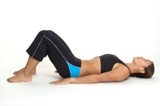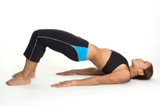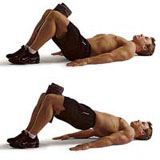— ARCHIVES —
Exercise of the Month - September 2006: "Glute Bridge"
Chronic disability specific to the lumbar spine (region of the lower back) resulting from an array of often unidentifiable causes is rising exponentially in Western civilization. It’s been noted that an estimated 80 percent of all Americans will suffer from back pain at some point in their lives, the majority of which occurs in the infamous lumbar region. Too often, sufferers of low back pain have been prescribed bed rest and prolonged inactivity. While this author is certainly not attempting to diagnose all those afflicted, it’s been proven in the scientific literature* that patients with acute low back pain who continue ordinary activities within the limits permitted by the pain (including exercise) experience more optimal recovery than either bed rest or back-mobilizing exercises. As trainers, therapists, etc… we need to encourage our clients, patients, etc… to remain comfortably active, unless contraindicated in certain situations. Proper low back care must be developed early on in life to ensure form and technique during activities of daily living (ADL). Engaging in specific exercises to prevent compensatory movement of the lumbar spine (i.e. learning to lift with the legs instead of the back) is essential for long-term back health.
 Performing the “glute bridge” is a great way to teach the butt muscles to activate/”fire” in an effort to recruit them during activities when they are needed (i.e. squatting to pick an object up off the ground). To execute the glute bridge, lie face up on the floor with knees bent at 90 degrees. Lift the toes to activate the muscles in the front of the lower leg (i.e. tibialis anterior).
Performing the “glute bridge” is a great way to teach the butt muscles to activate/”fire” in an effort to recruit them during activities when they are needed (i.e. squatting to pick an object up off the ground). To execute the glute bridge, lie face up on the floor with knees bent at 90 degrees. Lift the toes to activate the muscles in the front of the lower leg (i.e. tibialis anterior).
 With your belly button drawn in (ensures activation of transversus: see August “Exercise of the Month”), extend your hips upward by activating the glutes. Keeping the head and upper back/rear shoulders pressed into the floor, make sure to simply extend the hips and not arch the lower back/lumbar spine. To make this exercise more difficult, several progressions can be carried out. The following is a series of progression suggestions:
With your belly button drawn in (ensures activation of transversus: see August “Exercise of the Month”), extend your hips upward by activating the glutes. Keeping the head and upper back/rear shoulders pressed into the floor, make sure to simply extend the hips and not arch the lower back/lumbar spine. To make this exercise more difficult, several progressions can be carried out. The following is a series of progression suggestions:
 Simply increase the amount of time each contraction is held before lowering the butt toward the ground (i.e. increase each rep by 3-5 seconds)
Simply increase the amount of time each contraction is held before lowering the butt toward the ground (i.e. increase each rep by 3-5 seconds)- Place rolled towel or Pilates block between thighs and squeeze the knees together against the object in an effort to engage the adductors isometrically [see picture].
- Place a band around the thighs and spread knees apart in an effort to engage the abductors throughout the pose [see picture].
 Attempt a single-leg version
Attempt a single-leg version - Progress to performing the pose on a Swiss ball [see picture]. This should recruit many stabilizing muscles not normally engaged when performing the activity on a stable surface.
*Malmivaara, A. (1995). The Treatment of Acute Low Back Pain- Bed Rest, Exercises, or Ordinary Activity? New England Journal of Medicine, (332)6, 351-355.

